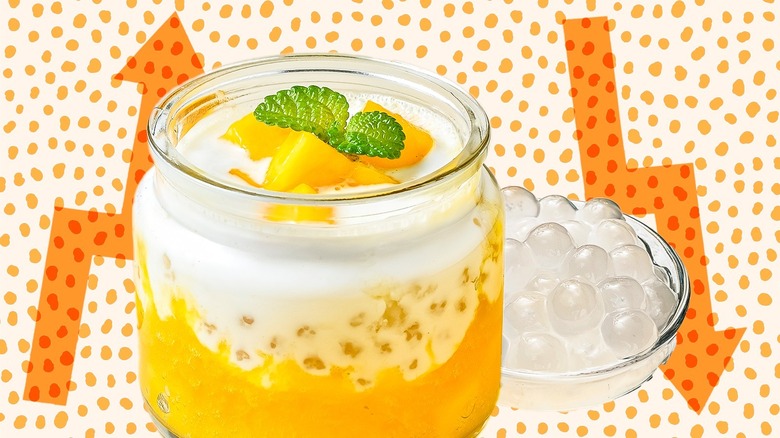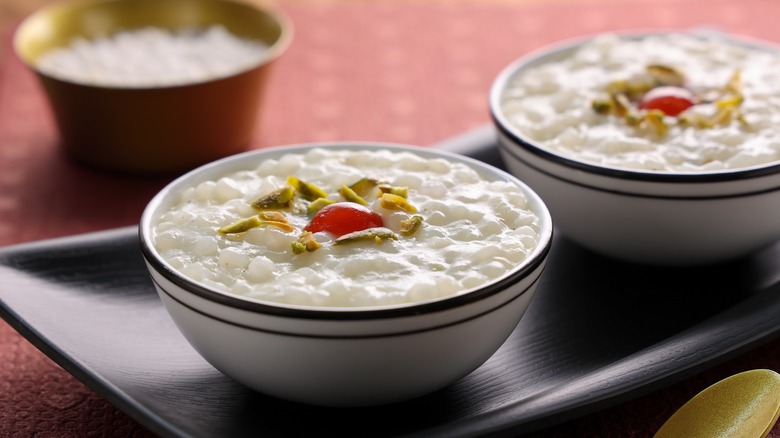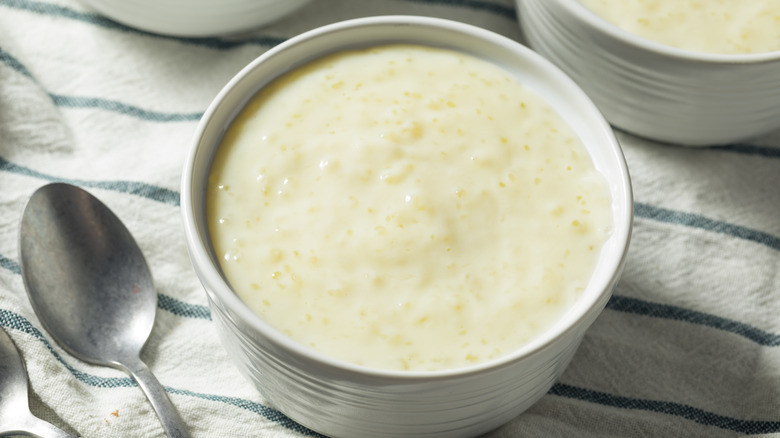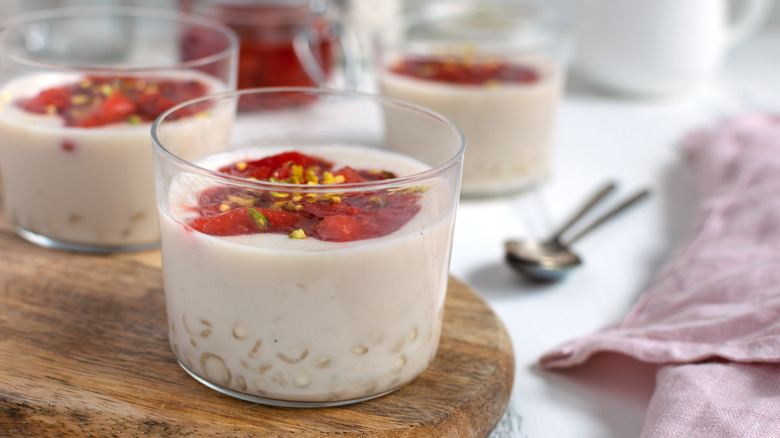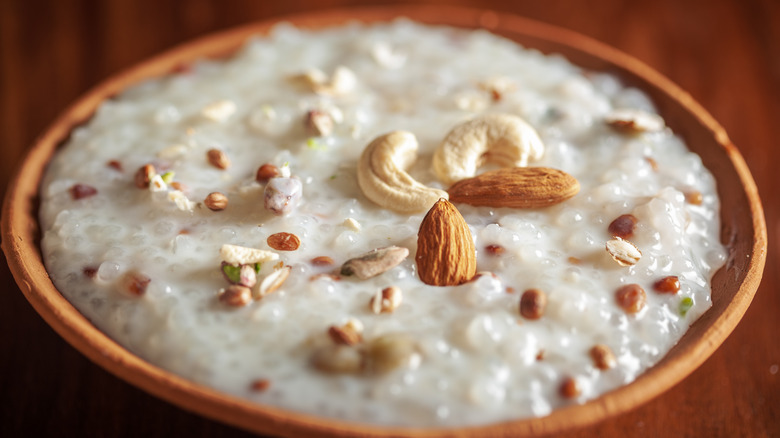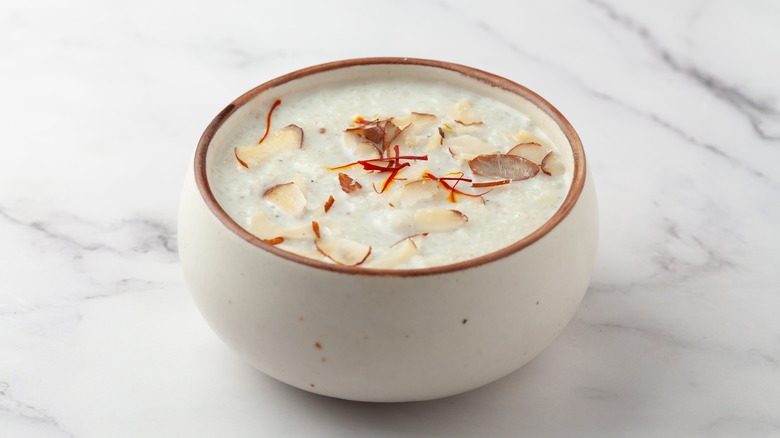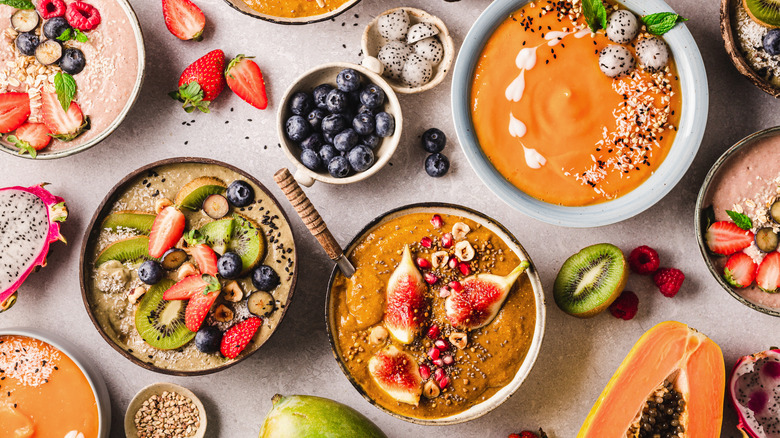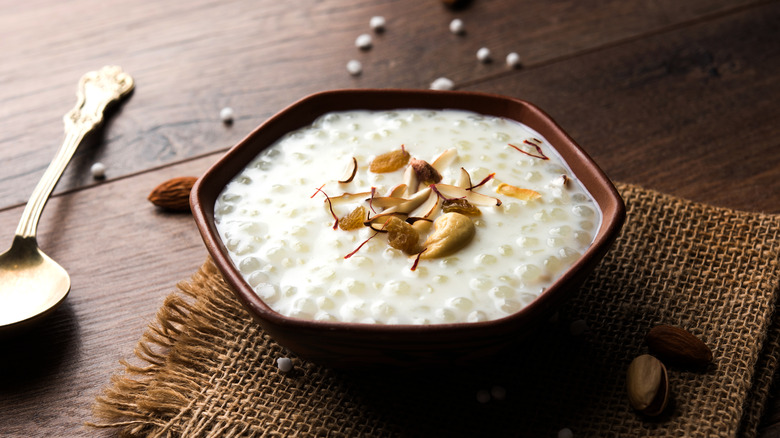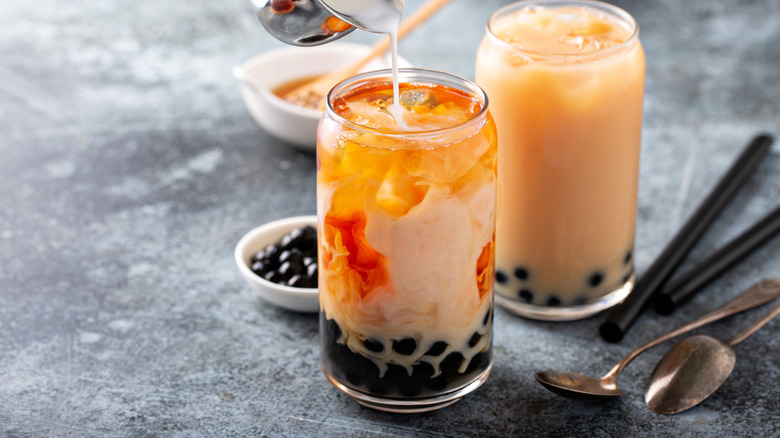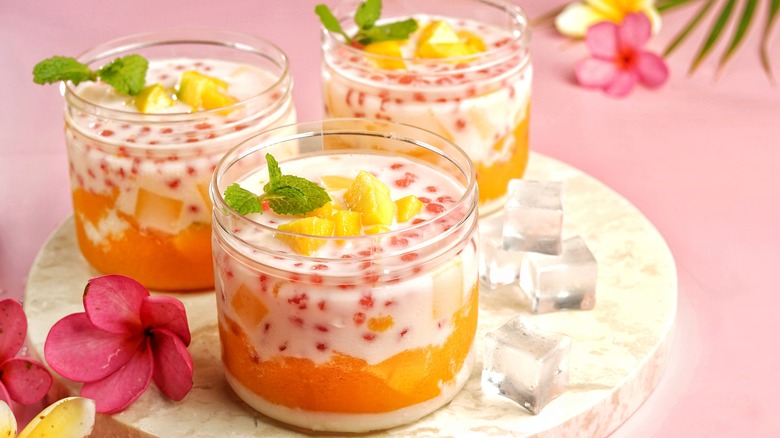The Rise And Fall Of Tapioca Pudding
Have you ever wondered what happened to tapioca pudding? It falls into a category of foods that used to be in demand that nobody eats anymore, like gelatin salad, turtle soup, and meatloaf. If you're young, the chances are you haven't ever tasted (or perhaps even heard of) tapioca pudding, as it fell out of vogue some time ago.
Other generations may remember being served this dessert during school lunches or at relatives' houses. Perhaps you despised the meal and would worm your way out of eating it, or maybe you were one of the few who enjoyed the polarizing dish. Either way, this is the perfect chance to learn more about the long history of tapioca pudding, from its origins in South America, transportation by colonial traders, its eventual place on our dinner tables — and finally, its unceremonious disappearance.
We'll delve into possible reasons tapioca pudding became popular with the masses, whether it ever truly deserved its relegation to the sidelines, and if a comeback for the creamy dessert is on the horizon. In short, we're investigating the rise and fall of tapioca pudding — pun intended — and we want you to be the Watson to our Holmes as we unravel the mystery.
Tapioca was cheap, adding to its popularity
Just one attribute contributed to tapioca's early success: its affordability. Let's go back in time over 8,000 years ago, when the first domestication of tapioca by communities in southern Brazil is estimated to have taken place — for context, that's roughly when the last Ice Age ended. Concurrently, people in Iraq started harvesting barley for beer and grain, making tapioca one of the earliest food sources.
Skipping forward, Spanish colonizers in Mexico introduced tapioca to the Philippines, where the local community quickly adopted it as a substitute for sago. Some years later, Dutch colonists brought the root crop (cassava) to Indonesia, where it dispersed across Asia. Comparatively, while sago took over 10 years to harvest, cassava was more sustainable (up to 18 months to mature) and much quicker to harvest, making it less labor-intensive and cheaper. These factors were the true beginning of tapioca's growing demand worldwide. As an economical alternative, it quickly replaced where sago was traditionally used, including puddings.
In the modern day, tapioca balls are no longer considered a budget ingredient but remain significantly more affordable than the alternative, sago. Another advantage is that tapioca pudding requires fewer ingredients than elaborate desserts like cheesecake, European pastries, cakes, or pies, making it a more economical choice for families when desserts are considered a luxury dish.
Tapioca pudding was once a celebratory July Fourth meal
Although we can't pinpoint the exact point in history when tapioca pudding entered North America, there are accounts of people enjoying the dessert from as early as the 1860s. One of the earliest references to tapioca pudding in the U.S. is from a memoir by Captain of the Second Rhode Island Volunteer Infantry, Elisha Hunt Rhodes. During the legendary siege of Petersburg in the Civil War, he describes hosting a Fourth of July celebration in the trenches with his fellow soldiers. They feasted on numerous luxury canned items and three desserts: apple pie, bread pudding, and tapioca pudding.
Nowadays, we typically celebrate with patriotic red, white, and blue-themed foods for the July 4th Independence Day festivities. Tapioca pudding seems a far cry from the elaborate cakes, trifles, and fruit platters on most dining tables — but Rhodes' diary points to the fact that during wartime, the creamy dessert was the epitome of indulgence. It seems that all milk-based desserts, like tapioca pudding, were highly coveted delicacies, so much so that some soldiers resorted to rifling through others' packs to acquire them!
Now that many families struggle with food prices due to inflation, studies say the cost of holding 4th July cookouts continues to rise, causing people to consider cutting down their guest list or switching ingredients. Could it be time to introduce tapioca pudding to the festive menu again, just like Captain Rhodes? We'll leave that up to you.
An American housewife kickstarted its widespread availability
By the late 19th century, tapioca pudding had already gained popularity and was in high demand across the U.S., lauded for its faraway origins. Despite its reputation as a dessert for invalids tapioca remained popular, with advertisements suggesting everyone, from "grown-ups" to children, seemed to enjoy eating the pudding.
However, mass production and accessibility are fundamental to creating household staples. Tapioca pudding was neither of these. Traditionally, the tapioca needed soaking upwards of six hours, making it a time-consuming option. That is, until a Boston-based housewife named Susan Stavers entered the scene.
As the story goes, Susan ran a boarding house. In 1894, she took a sick sailor returning from South America into her care and used the cassava roots he had in his luggage to make him a restorative pudding. However, Susan did something revolutionary; she ran the ingredients through a coffee grinder. The boarders, including the sailor, loved the pudding, and word soon spread of her recipe. She began peddling the food on the streets of Boston, and it wasn't long before a newspaper publisher, John Whitman, saw an opportunity. He bought the rights to her recipe and founded the MINUTE Tapioca Company. The company enthusiastically claimed its new product, could be made "as quickly as you can make a pitcher of lemonade," (via Food Timeline). In the 1920s, General Foods (now Kraft) bought the MINUTE Tapioca Company, and over the following decades, tapioca pudding would steadily fall out of favor.
School lunches put off elder generations
Do you remember your old school lunches? While some people fondly recall sitting in the school lunch hall with canteen trays, most remember the meals with less nostalgia. For some people, school lunches elicit a shiver down the spine — and there's one primary culprit. Yes, you guessed it: tapioca pudding.
While many young adults today likely didn't experience tapioca pudding growing up, the prior generation certainly did. Dare to ask, and people who attended school between the 1950s and '60s will likely describe the dish as anything from "eyeball pudding," and "frogspawn," to "fish eyes," painting nightmarish horror stories. School lunches around the world served the thick and creamy dessert, citing its high calcium levels, although it was most widespread in Britain, the U.S., and Australia.
As children, the pupils reluctantly ate (or tried to get out of eating) the "frogspawn," but as adults, the story changed. When they found themselves in control of their eating for the first time, they refused to introduce the meal to their future children or grandchildren. Instead, unlike other comfort foods you may have forgotten, tapioca pudding was remembered as a fuel for nightmares. Its reputation suffered irrefutable damage, and an early 2000s poll — taken from people who ate the meal at school in the '60s – awarded tapioca pudding the dubious prize of most hated school lunch in the U.K. (via The Guardian). Despite attempts from celebrity chefs to revive the dessert, it hasn't yet recovered its standing.
It has a reputation for being bland with an unappealing texture
Tapioca boasts a neutral yet versatile flavor base like other starches typically incorporated into sweet puddings — such as rice, arrowroot, and semolina. This characteristic can be a boon or drawback, contingent upon how home cooks utilize the ingredient.
In our globalized world, tastes have evolved significantly. According to KSL-TV, historian and Yale professor Paul Freeman asserts that people as recent as the late 19th century "didn't like spices because they [thought] they created indigestion and were a distraction from the actual food." These beliefs could clarify why the uncomplicated flavors of tapioca pudding weren't a drawback in past centuries. When we contrast that with the modern world, where spices are more affordable and easily accessible, it's understandable why some might find these straightforward flavors "bland." Luckily, there's an easy fix. Pair tapioca pudding with tropical flavors like coconut and cardamom, flavor it with pandan leaf (a popular addition to the original Asian sago pudding), or follow the British lead and top it with a healthy dollop of berry jam.
Further adding to the issue is the texture of tapioca pudding. When cooked, tapioca pearls take on a bouncy, slimy texture and translucent color that can easily seem unappealing to unfamiliar diners, especially those with textural aversions. Advertisements from the late '50s describe the dish as "as light as a bubble," (via Reddit) while netizens today claim "the slimy texture makes it inedible," (per The Guardian).
It's now considered an out-of-date, retro recipe
It's not groundbreaking to say tapioca pudding is outdated. It's a retro dish on par with other historic recipes, like Jell-O salad and salmon mousse — dishes widely cooked in the 1950s – '70s that have since fallen out of vogue.
While it's true that not all retro recipes have the same negative association — look at apple pie, beef stroganoff, or mac and cheese, for example — those are the exceptions. As new fads take over, health advice changes, or markets stop stocking certain ingredients, most recipes with a history as long-lived as tapioca pudding fall by the wayside.
Worsening the case, the perception of tapioca pudding as "just boba for old people" (via X, formerly known as Twitter) persists, and Pennsylvanian radio station HOT 106.7 hosts say they "immediately think of tapioca pudding" as "old people food" (per Facebook). All of this to say, it can be hard to persuade a new generation of cooks to explore retro recipes. Rather than cooking from vintage cookbooks, people now rely on social media or food blogs for trendy, modern recipes, leading to a lack of exposure to tapioca pudding and exasperating the issue.
Tapioca isn't very nutritious, and healthier desserts are in fashion
One of tapioca pudding's rise to prominence was its distinction as a highly nutritious option to feed growing children and those suffering from stomach problems. Tapioca pudding contains tons of milk so it was considered a vital source of calcium — crucial for bone health. However, we now know tapioca, on its own, isn't a good source of nutrients; as a pure starch, it has minute amounts of fat and protein and few vitamins. This puts tapioca pudding on the same level as indulgent desserts like chocolate cake, fruit pie, or ice cream sandwiches. And let's face it, those are so much more irresistible.
There's a persistent trend towards wholesome, nourishing desserts. Imagine anything from vibrant smoothie bowls made with spirulina to chai seed-topped homemade acai bowls, banana "nice-cream," vegan chocolate mousse with tofu, or our latest obsession, outstanding oatmeal recipes that double as either breakfast or dessert. This nourishment-focused movement is evident across school meal initiatives, home baking trends (since COVID-19, banana bread is more popular than ever), and social media feeds.
So, how can you make tapioca pudding healthier? Try incorporating other ingredients into the dish, like plant-based milk (coconut is a favorite, although other nut or oat milk work well), protein powder, nut butter, whole seeds, or chopped fruits. Our blueberry lemon tapioca pudding is the perfect example of elevating the retro dessert to include more vitamins while upgrading the flavor profile.
Tapioca pudding is still beloved as ever in some countries
Although tapioca pudding has experienced a significant decline in popularity across North America, the U.K., and Europe, it remains beloved and widely enjoyed in South Asian countries. Tapioca pearls arrived in India from Southeast Asia over half a century ago, in the 1940s. At first, the ingredient went unnoticed and unappreciated, as the local food culture wholly relied on the local food crop, rice. During the aftermath of the Second World War, everything changed. South India faced a rice shortage, prompting the kingdom's rulers to adopt tapioca as a vital food source to avert potential famine. Since then, tapioca has cemented its place in India's culinary landscape.
It didn't take long for Indian people to incorporate tapioca pearls into the traditional milk pudding dish, kheer (usually made with rice, vermicelli, or grated vegetables). The creamy concoction is a must-try Indian mithai (sweet) called sabudana kheer. Home cooks gently simmer sabudana kheer until the milk thickens, then sweeten it with golden-brown caramel-like jaggery or white sugar, and finally add subtle touches of ground cardamom, nutmeg, floral saffron, and assorted nuts.
Millions of people across India, Pakistan, and Bangladesh each have slightly different riffs on the basic recipe. People savor the indulgent treat on festivals –especially those that require fasting, known as vrat (in this case, denoting abstinence from certain foods only) — as well as birthdays, wedding feasts, and other auspicious occasions.
Tapioca became popular in other forms
Every day, the world becomes more multicultural, and for food enthusiasts, that's exciting. It means we have increasingly easy access to countless ingredients, recipes, and dishes that once would have necessitated globetrotting — a luxury few have the means for.
Undeniably, one of the biggest global success stories is boba tea (also known as bubble tea), a traditional Taiwanese drink consisting of a creamy, milky tea base (black, green, or oolong tea) completed with chewy, sweet, and syrupy brown sugar-soaked tapioca balls, plus flavorings such as red bean, fruits, aloe vera, or coconut. Boba tea recipes vary, and most shops offer highly customized options, but they always include sweetened or unsweetened tapioca pearls.
Since the 1990s, this tapioca-based drink has taken over the U.S., starting on the West Coast, with boba tea shops appearing everywhere from San Francisco to New York. Although the tea first only appealed to the Asian American demographic, the craze soon spread, with the beverage's unique colors and Instagrammable appearance spiking popularity nationwide. Now, we ask: Will the widespread adoption of bubble tea in the American diet translate to success for other tapioca-based foods, such as tapioca pudding? This popular Asian beverage has introduced many to tapioca who may have previously been hesitant. However, since people usually purchase boba tea while tapioca pudding rarely makes its way onto shop menus, it could have no effect; only time will tell.
Will tapioca pudding find popularity in the U.S. again?
Not all is over for tapioca pudding in the U.S. All signs point to tapioca pudding making a comeback: Other tapioca-based sweet treats (such as boba) have surged in popularity, and there's also a resurgence of vintage dishes like devilled eggs and fondue. Besides, there are plenty of reasons to enjoy the specialty food — did we mention it's naturally gluten-free and easy to make into a vegan dish?
So, if it's been decades since you last tasted tapioca pudding, perhaps it's time to put any negative connotation behind you and grab an apron, a pint of milk, plus a few spices — the delicious results might surprise you. And, for those who have never tasted the classic dish, don't let the naysayers put you off; the creamy pudding is a cherished festive dessert elsewhere for a reason.
Want to be ahead of the trend? You'll need to learn more about tapioca and how to cook with it. And, since tapioca pudding has fallen out of public favor, you may wonder where to find tapioca pearls. Skip the national grocery stores and head straight to your local Asian market, buy a bag of tapioca pearls, get cooking, and see whether the divisive dessert deserves to be at the forefront of American cuisine or should continue to fade into obscurity.
